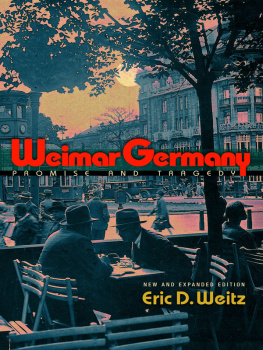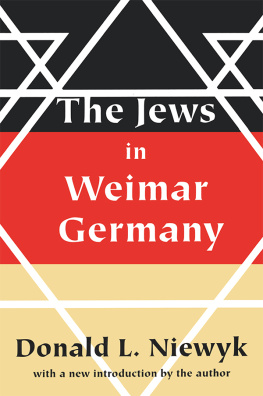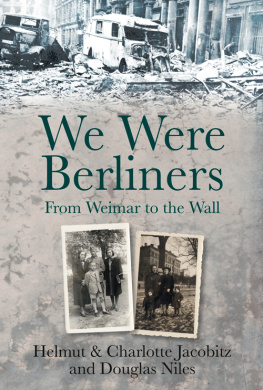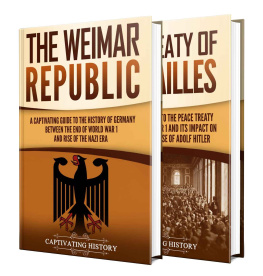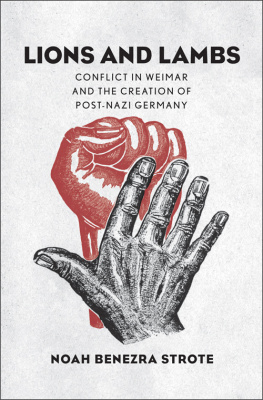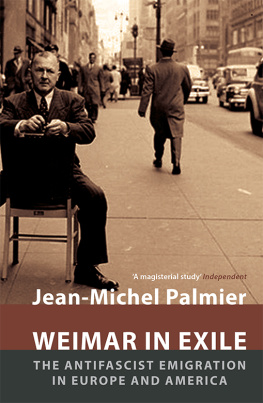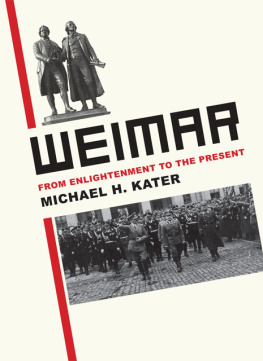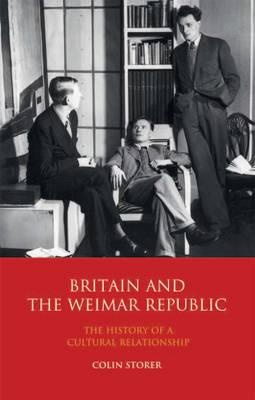
Weimar Germany

Copyright 2007 by Princeton University Press
Published by Princeton University Press, 41 William Street, Princeton, New Jersey 08540
In the United Kingdom: Princeton University Press, 6 Oxford Street, Woodstock, Oxfordshire OX20 1TW
press.princeton.edu
All Rights Reserved
All efforts have been made to locate copyright holders of illustrations. If any have been missed, adjustments will be made in subsequent editions.
First printing, 2007
Fifth printing, and first paperback printing, 2009
New and expanded edition, 2013
Library of Congress Control Number 2013930694
ISBN 978-0-691-15796-2
British Library Cataloging-in-Publication Data is available
This book has been composed in Berkeley Typeface with Bauhaus display
Printed on acid-free paper.
Printed in the United States of America
10 9 8 7 6 5 4 3 2 1
T o the memory of my father, Charles Baer Weitz (19192011), and mother, Shirley Wolkoff Weitz (19252004), who first taught me the importance of learning
Contents
Illustrations
Color Plates (following p. 274)
Figures
Weimar Germany
INTRODUCTION
W eimar Germany still speaks to us. Paintings by George Grosz and Max Beckmann are much in demand and hang in museums and galleries from Sydney to Los Angeles to St. Petersburg. Bertolt Brecht and Kurt Weills The Threepenny Opera is periodically revived in theaters around the world and in many different languages. Thomas Manns great novel The Magic Mountain, first published in 1925, remains in print and, if not exactly a household item, is read and discussed in literature and philosophy classes at countless colleges and universities. Contemporary kitchen designs invoke the styles of the 1920s and the creative work of the Bauhaus. Postmodern architects may have abandoned the strict functionalism of Walter Gropius, but who can resist the beauty of Erich Mendelsohns Columbus House or his Schocken department stores (only one of which is still standing), with their combination of clean lines and dynamic movement, or the whimsy of his Einstein Tower? Hannah Hch might not be as widely known as these others, but viewers who encounter her work today are drawn to her inventive combination of primitivist and modernist styles, her juxtaposition of African or Polynesian-style masks with the everyday objects of the 1920s. The deep philosophical speculations of Martin Heidegger and the layered essays of Siegfried Kracauer, both grappling with the meaning of advanced technology and mass society, still offer a wealth of insight into the modern condition. And what film buff has not seen The Cabinet of Dr. Caligari, Metropolis, or Berlin: Symphony of the City?
Weimar Germany speaks to us in other ways as well, perhaps most often as a warning sign. This was a society battered by economic crisis and unrelenting political conflict. World War I cast its long shadow over the entire history of the republic. However much present-day economists and historians have revised the notion that the Versailles Peace Treaty placed excessive financial burdens on Germany, Germans of the time were convinced that they had been unjustly treated by the victors of World War I. Many were quick to blame the Allies and, following the stab-in-the-back legend, Jews and socialists at home for every subsequent disaster that ensued: civil unrest, hyperinflation, depression, bankruptcies, and any other kind of misery one can imagine. Weimar Germany conjures up fears of what can happen when there is simply no societal consensus on how to move forward and every minor difference becomes a cause of existential political battles, when assassinations and street fights run rampant and minorities become the easy scapegoats of antidemocratic forces. It is a warning sign because we all know how it ended: with the Nazi assumption of power on 30 January 1933.
Yet amid the conflicts and disasters, Weimar was also a moment of great political as well as cultural achievement. The destruction of the old imperial order in war and revolution unleashed the political and social imagination. For a time, Germans created a highly liberal political order with very substantial social welfare programs. The lives of so many ordinary people improved greatly: the working day was reduced to a more humane eight hours, at least in the first years of the republic, and unemployment insurance seemed to herald a new era that would protect workers from the vagaries of the business cycle. New public housing offered better-off workers and white-collar employees the chance to move out of old tenements into modern, clean apartments with indoor plumbing, gas stoves, and electricity. Women won the right to vote, and Germany had a lively free press. All sorts of plans were broached for creating the flourishing and harmonious society of the future, from nudism to communism. Sex therapists and popular activists asserted the right of everyone to a rich and fulfilling sexual life. Like the cinema, the spectacle-world of consumer goods conjured up the possibility of a different, more prosperous life, even if one had to return next morning at 7:00 AM to the workbench, office, or sales counter. Utopian beliefs emerged out of war and revolution. Surely the world could be completely transformed, whetherdepending on the spokespersonthrough modern architecture, photography, communal housing, or massed demonstrations in the streets: such confidence and conviction proved inspirational to so much artistic creation and philosophical rumination.
Germans were hardly alone in these endeavors. In the swirl and wake of World War I women won the right to vote in Britain; modern artists flocked to Paris; Dutch architects pioneered new building forms; and crowds and parties in Vienna, Budapest, and Petrograd overthrew antiquated imperial regimes and hoped for a bright political future. Germans watched and learned from these developments, for good and bad. But there was something particularly intense and concentrated about the German experience in these years. Unlike its neighbors to the west, Germany had lost the war. The economic, political, and psychological consequences were profound. Virtually every issue, every debate, was shadowed by the question of responsibility for the war and the cost of reparations. With no victory, there was no recompense for the sufferings men and women had endured for four years. There were no financial gains, no sense of the elation that comes from triumph after a struggle long endured. Unlike its Russian neighbor further to the east, Germany did not go through a total revolution that completely eliminated the power and prestige of the traditional elites. It steered a middle course with a revolution that most certainly democratized the country but left much of the old social order intact. The result was lack of consensus and constant debate. The most basic matters of how Germans would live together and with their neighbors were subject to unending strife.
The destructiveness of total war and the creativity of revolutionexperiences that many Europeans shared, but that in Germany had a very particular colorationpropelled the work and thinking of Weimars protagonists, whether they were visionary artists and architects, political reformers and revolutionaries on the left, or thoughtful, authoritarian-minded intellectuals on the conservative right. They were also animated by something deeper and of longer durationthe recognition that they were living amid the throes of modernity. Germany in the 1920s still had a very significant agrarian economy, many small shops and skilled handicraft workers, and elites of an older sort well ensconced in the officer corps of the army, the bureaucracies of the state, and the hierarchies of the Protestant and Catholic churches. But the old world, often idealized in retrospect, of aristocratic estates and peasant farming; of individual German states and a unified Germany dominated politically by princes, kings, and emperors; of rigid class distinctionsthat world no longer existed unchallenged. The center of gravity had shifted to the city with its cacophony of sounds and images, to the factories and mines pounding out the products of an advanced industrial economy, and to the tensions and excitements of mass society. This was a world in which most individuals worked for a wage or salary; people patronized the icons of a commercial economy and culture by reading newspapers, shopping in department stores, listening to prizefights on the radio, and going to the movies at least once a week; and politics included mass mobilizations to get out the vote, march on city hall or the nearby factory, and, sometimes, take up arms in revolution and rebellion.
Next page
